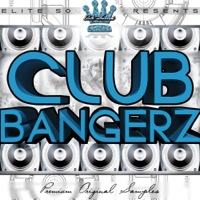
There’s also a little more sustain in the overall signal. That’s because our ear hears distortion and midrange tones as being louder than low end. You’ll notice this 808 appears a lot louder than the others. I’m then using an EQ to boost those overtones, and a compressor to reshape the attack to have a similar attack as the original. This analog clipping creates some really crazy sounding overtones. In this example I’m running the 808 into the tube amp in my compressor (not doing any compression) and turning the gain up all the way. This particular example is crushed and then low-pass filtered to get rid of some of the high end digital distortion that stems from it. !llmind’s drums are often bit crushed to give them that extra gruff tone. The classic SP-12 sound partially comes from the fact that it’s a 12-bit sampler. It’s unique in that it comes from digitally reducing the resolution of a sound. You lose a little of the “bounce” and “fullness,” but you gain a little more “punch” and “forwardness.” Only context can tell you what’s better.īit-crushing is yet another form of distortion. And remarkably, doesn’t sound all that different from the original. What’s happening is the sum of many things: the saturation effect is adding subtle compression and overtones, while choking off some of the higher overtones, and the filter is boosting the sub, but also shortening the decay tail. What that means is that I’m using a high-pass filter, and wherever I set the frequency gets a big boost. I’m using just a hint of it, and I’m also using the “thump” setting on the high-pass filter. On this I’m using a plugin called Decapitator. Saturation is just a friendly name for subtle distortion. The output is run just a touch hot (not red though), which gives it just a bit of grit while retaining the sense of dimension. This 808 is an actual TR-808 kick resampled through an MPC. Ll examples are level-matched, meaning they have the same amplitude, even if they appear to be louder or quieter.Ĭhoosing a good 808 to begin with is key. The common theme here is “overtones.” In almost every example I’m generating some kind of harmonic content that let’s the 808 feel more present without actually increasing the volume of the 808 itself. I’ve included an audio sample of all 808s played in succession. Having this extra octave and dubbed punchy kick helps the 808 cut through the mix. In this record, you’ll notice the 808 has a lot of “tone” to it, and there is a punchy kick dubbed in with it. Let’s look at “John” by Lil Wayne and Rick Ross. Keeping the bass and midrange fairly open will allow the 808 to stand out.īut not every record warrants a sparse arrangement.

Let’s say you want a clean, subby 808 that stands out. Of course, to have an 808 that just fits in the record, you need an arrangement that makes sense for it. Nothing beats an 808 that just fits the record.Ībout 50% of the time, when I’m doing a record with an 808 kick line - which is pretty often - I just turn it up! I set it in the mix where I like it, and that’s the start and end of it. So don’t feel you have to be limited to an 808 to get a great “808” kick source sound.Īnd the source sound really is key. You can make a decent, or even exceptional 808 from any synth that has an isolated sine wave oscillator. “ 808s and Heartbreaks,” for example, primarily relied on 909s. Many “808s” are not actually from a Roland TR-808 at all. Sine Wavesįirst, an 808 kick is a catch-all for sine wave based kicks. But I’m going to break it down along with some audio examples. Making 808s really hit hard can be a little tricky. This article has pretty much been due for a while.


 0 kommentar(er)
0 kommentar(er)
